Managing Disc Herniation and Alleviating Sciatica: Tips and Tricks 1
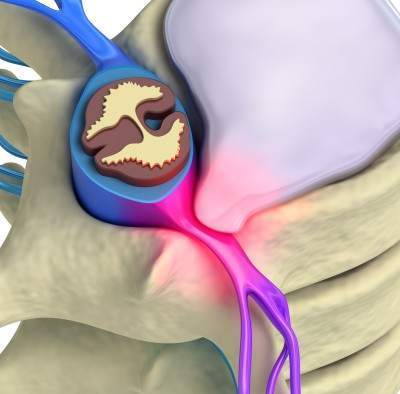
Suffering from disc herniation? Experiencing sharp pains shooting through your buttock, thigh, and leg due to sciatica? If your daily routine is disrupted by the discomfort of disc herniation, there’s hope. Many people find relief without needing surgery. This post will guide you through lifestyle changes to support your recovery from disc herniation. Stay tuned for our next piece, where we’ll explore exercises to correct and stabilize your condition.
Ultimate Guide To Exercises For Lumbar Disc Herniation Relief
Mary’s Story: A Wake-Up Call
Imagine starting your day like any other, performing your routine toe touches, when suddenly you’re hit with an excruciating pain radiating from your lower back down to your toes. This was Mary’s reality when she encountered a lumbar disc herniation, commonly referred to as a slipped or ruptured disc. Such incidents can lead to what’s known as sciatica or radiculopathy, terms doctors use to describe the pain that extends down your leg.
Understanding Lumbar Disc Herniation:
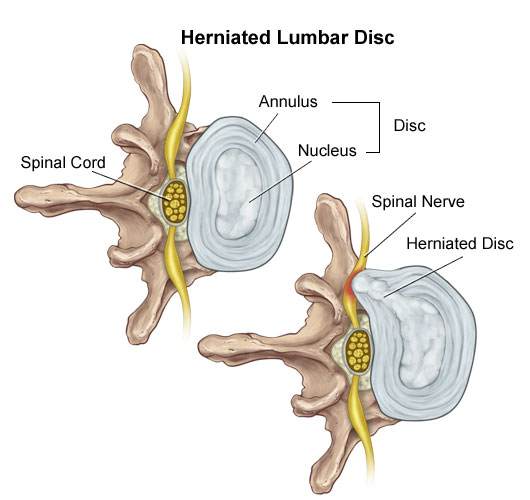
A glimpse into the anatomy of a herniated disc reveals two main components: the tough outer annulus and the softer, inner nucleus. Dr. Stuart McGill likens the nucleus to sticky phlegm. When Mary bent forward, it was akin to squeezing the front of a jelly doughnut, pushing the inner material backwards and eventually causing the disc to bulge and press on a nerve.
The Culprit Behind the Pain:
Mary’s disc herniation wasn’t a sudden mishap but the result of years of repetitive motions like toe touching and prolonged slouching at her desk. These habits gradually weakened her disc, leading to the moment when it finally herniated and impacted her nerve. The lack of nerves within the disc itself means significant damage can occur without immediate pain, explaining why the problem might not be felt until it’s severe.
A Lesson Learned:
The story underscores the importance of posture and the dangers of neglecting spinal health. While the advice to “sit up straight” might seem simplistic, maintaining the natural curve of your back is crucial. Mary’s experience serves as a potent reminder of the long-term consequences of poor posture.
Disc herniations don’t have to dictate your life. By understanding the causes and adopting preventive measures, you can manage and alleviate your symptoms.
Understanding Disc Herniation: Pain, Prevention, and Care
The Unseen Progression of Disc Herniation (see picture above)
- Bulging Disc: Early stages where the disc starts to protrude due to wear and tear.
- Prolapsed Disc: The disc bulges more as it degenerates, but the nucleus remains contained.
- Extruded Disc: The protective layers give way, pressing on nerves and causing pain.
- Sequestrated Disc: The most severe stage, where disc fragments break away, potentially compressing nerves or the spinal cord.
See Also: MRI, CT scan and X-rays: Is an MRI, CT Scan or X-ray Best For My Pain?
Why Me? The Role of Movement and Genetics in Disc Herniations
Surprisingly, your daily habits and genetic makeup play pivotal roles in disc health. While we can’t choose our genetics, modifying daily movements can significantly reduce the risk of herniation. Proper lifting techniques and posture adjustments are crucial first steps.
Simple Changes, Major Impacts: Daily Habits and Exercise
To protect your spine:
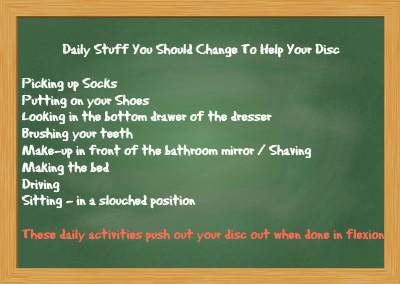
- Adjust Daily Habits: Learn to perform everyday activities in spine-friendly ways to prevent further disc damage.
- Disc-Specific Exercises: Exercises can help reposition the herniated disc.
- Stabilization Routines: Strengthening your core helps maintain spinal integrity, preventing future herniations.
Lifting Techniques: How Weight Lifters Should Lift
Master the Basic Butt-Lifting Technique for Disc Health
- Practice with a long, straight object to ensure your back remains aligned.
- Ensure it touches your butt, mid-back, and the back of your head during the entire motion.
- Squat down and maintain contact with 3 areas and keep the lower back arched the whole time.
- Aim for 30 repetitions to embed this healthy habit into your daily routine for 10 days
Daily Activity Guide: Protecting Your Discs
Then you integrate this lifting technique into everyday life. Initially, whenever you do any of these activities, use the same basic move and you will stop pushing out your disc.
In the beginning, you will need to be conscious each time you are doing any of these activities. To speed things up you can practice each activity like picking up your socks 30 times using the butt lifting technique and it will become even more automatic. You can deepen muscle memory during all of these activities.
For sitting in a chair and driving I recommend that you roll up a Mckenzie Lumbar support roll and put that in the arch of your lower back
Guide for disc herniation daily activities.
- Remember to do all these movements pain-free. Always stop whenever you run into pain with any movement of the spine.
- Disc herniations are linked with long periods of sitting, especially prolonged driving.
- Disc herniations are caused by repeated flexion.
- Prolonged trunk flexion or twisted or bend sideways cause disc herniations.
- Too much lifting, pushing/pulling causes disc herniations
- Vibration while sitting is linked to disc herniations.
- After prolonged stooping or sitting, you should stand. For example, a gardener lifting bags of peat moss after having a prolonged period of rounded lower back, or a driver getting heavy loads out of the trunk after a long drive is not recommended. You should remember to stand for a few minutes before attempting to lift. Studies have shown that ½ hour is even better.
Here are some more exercises that can cause disc herniation.
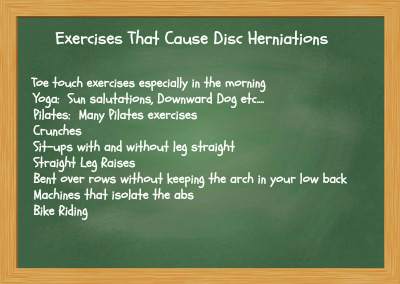
Activities That Put Out Lumbar Disc Herniations
Yes, it’s very surprising that toe touches, Yoga and certain Pilates can cause disc pressure leading to disc herniations. I have personally treated dozens of Yoga teachers with varying degrees of experience. The fact is some of the exercises involved in Yoga are great for helping disc herniations while others directly push the disc out.
Many Yoga Exercises Put Out Disc Herniations
I know many Yogis who have had to stop many of their exercises due to the pain it cause them in various parts of the body, including their disc.
Next week’s article will go over the second and third ways to help your disc. Remember, you need to do #1 “Daily Disc Activities Correctly” first so that your disc doesn’t keep getting aggravated. Then you can move on to next week’s article which goes over #2 Disc Exercises to Push the Disc Back In and #3 Stabilization Exercises help by keeping the disc from coming out by normalizing how your spine moves.
Looking Ahead: Comprehensive Care for Disc Health
Next week, we delve deeper into specific exercises for disc realignment and stabilization techniques, in this article called Ultimate Guide To Exercises For Lumbar Disc Herniation Relief. Remember, starting with correct daily activities is essential to prevent aggravating your condition further.
Tell us what you think in the comments below and like us on Facebook. This Toronto Downtown Chiropractor will answer all questions in the comments section.
Related Categories: Disc Herniation, Low Back Pain, Surgery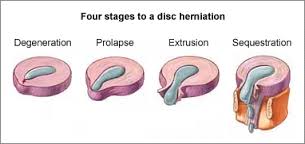
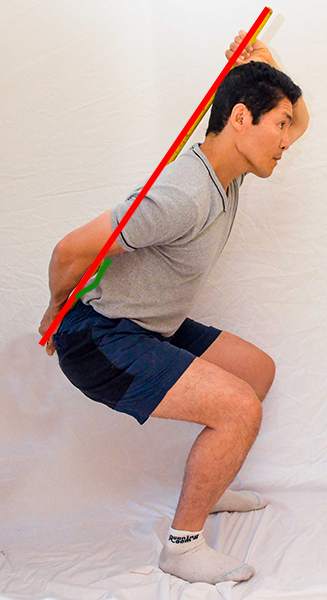



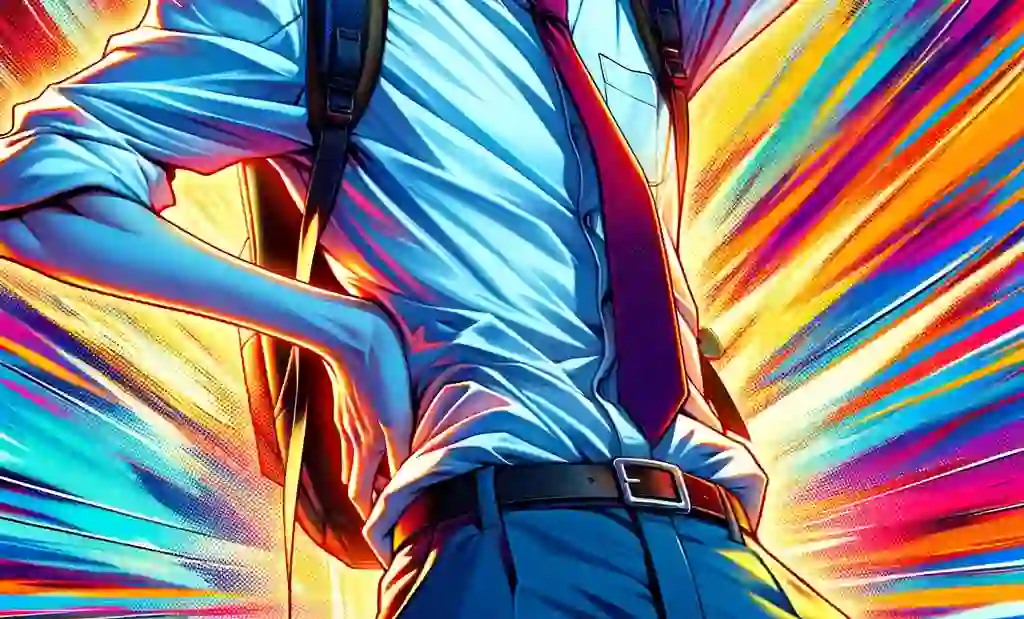

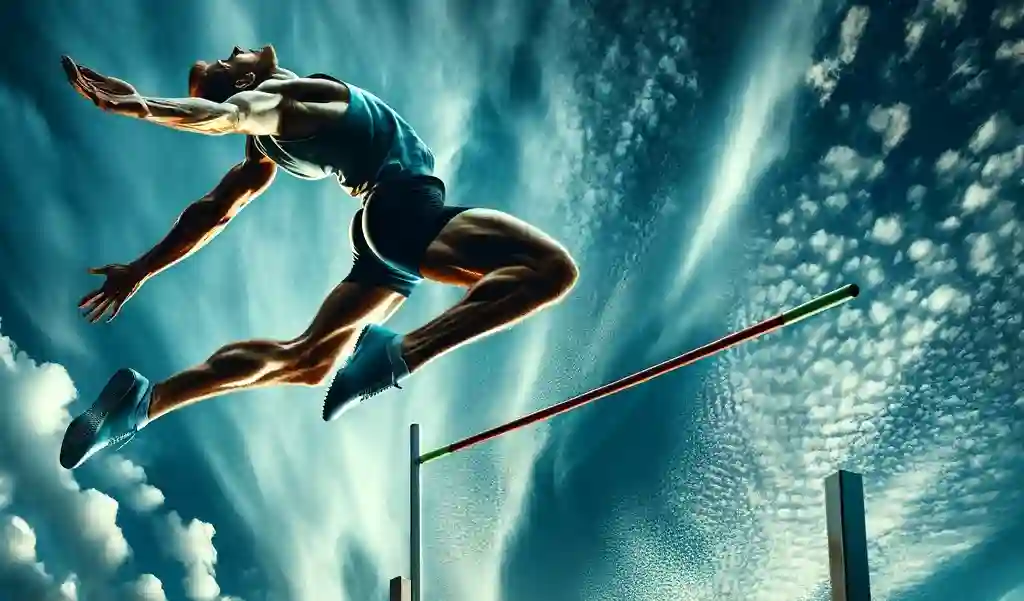
Logic you put is right sir…
Thanks a ton again sir…
(Would definitely like to see you, if I happened to come there in a short while.)
God bless…
Author
You are welcome Atul.
Thank You so much Dr. Ken for your advice.
Hope I could have been examined by you personally.
The work you do is really admirable… God bless u…
(Sir, I recently read research about “gelstix” & “discogel” – Intradiscal gel injection. Can it really be helpful..? Is that procedure available in canada..?
So I can come there from India, get examined by you, & get gel jab procedure done if you suggest.)
Author
Thanks for your question Atul. I can’t tell you if the “intradiscal gel injection” will be helpful. My first question would be that after you create a new hole in the disc wouldn’t it be easier for the nucleus to come out.
I certainly don’t do this procedure.
Good luck with your disc herniation.
Sir, thank you so much for reply.
There’s buring pain in lower back.
Pain in whole left leg back portion.
Numbness in left leg bottom part.
Sometimes numbness in left buttock.
Sometimes pain in anal area.
Testicular pain increases while sitting more than 40-45 minutes.
Pain decreases in left leg & lower back while lying down, & increases while walking more than 150 mtrs & standing for more than 15-20 minutes.
Pain increses in testicles in prolonged sitting & even more while driving a car.
Burning in urination is itermittently.
Constipation increases with increse of pain too.
Left leg has much starin & pain while applying clutch in traffic during driving…
Sleep is disturbed while having more pain in left leg, lower back & testicles…
Author
Thanks for your question Atul. You have a lot of pressure on your cauda equina. In fact you almost have cauda equina syndrome. This means you are on the verge of an emergency situation. Exercises that I give will not help as I cannot examine you. You need to see a health professional who can examine you. I cannot advise you further.
Hope you understand that you have a very serious issue with your disc herniation.
Hello Dr. Ken, I have a question concerning my dad, he says he’s had an injured disc for almost ten years now and the pain has never gone away. With massages, the pain temporarily decreases. But he also claims that every time he sits and bends over to put his socks and shoes on, he has really bad pain. It’s not easy for him to do some physical activities. Oh, he also did mention before getting massages or extending the time between massages causes pain, enough to the point where he cannot sit, stand or lay in comfort. Please help me understand what’s going on and what I can do to help him get better.
Author
Thanks for your question. The key is to not aggravate the problem everyday. Aggravating the problem all the time perpetuates the problem so that he will continue to have pain. He should do the exercises in this article.
Hope that helps your father’s disc herniation.
Hi, Dr. Ken! I am wondering if you can help me understand which exercises are best for me to try? I have severe low back pain and numbness and tingling down my left leg and foot. I am unable to stand or sit for more than a few minutes before the pain is overwhelming. Walking with ice seems to help a bit. Sometimes the tingling is in my right leg too. I had an MRI and it showed
L3-4: intervertebral disc is mildly decreased in height and moderately decreased in signal intensity with a mild annular disc bulge. Trace bilateral joint fluid.
L4-5: intervertebral disc is mildly decreased in height and moderately decreased in signal intensity with a mild annular disc bulge. No central canal or neural foraminal stenosis. Trace bilateral joint fluid.
L5-S1: intervertebral disc is mildly decreased in height and moderately decreased in signal intensity. A 3mm central protrusion of the intervertebral disc is seen with high-intensity zone mildly flattening the anterior aspect of the thecal sac. Minor facet joint degenerative changes are seen. No central canal or neural foraminal stenosis.
Author
Thanks for your question Tracey. Your disc herniation is likely causing your pain. I say this as many people have pains that don’t correlate to the MRI.
In your case you need to consult a health professional for your pain like a chiropractor or physiotherapist. Your case assuming that the disc is causing your pain is certainly not surgical but too severe for me to advise without an examination.
Hope that helps your disc herniation.
Thank you so much Dr. Ken for such a great work.
You are blessed to serve so many queries.
I’m Atul Paranjape from bangalore, India – an IT engineer, used to a lot of sitting desk work.
25 Dec’15:
I got a shooting pain lifting my 9 yrs old daughter. Couldn’t even toss & turn in bed the whole night. Then visited ortho-spine surgeon the next day, MRI got done, findings as follow;
1. Posterior bulging at L5-S1 (propensity towards left side) causing indentation over ventral aspect of dural theca and bilateral traversing nerve roots.
2. Annular tear is seen at L5-S1
Symptoms: Radiating pain in left leg, numbness, tingling in buttock left side, numbness in right leg toe & fingers, sometimes constipation, burning in urination, & sometimes testicular pain
Medicines given: oral steroid, pain killers, b12, NSAIDs etc.
Physiotherapy: only modalities like SWD, Traction, IFT / TENS alternatively, Ultrasound
30 Jan’16:
Situation was very little improved during last month, then WORSEN again.
Doctor suggested a surgery (just removal of bulged part, no fusion, as bulging was not too large according to him)
Visited another spine surgeon, repeat MRI done.
REPEAT MRI findings: same as previous one, no significant changes
Treatment: change in some medicines, same physio session
15 Feb’16:
Nerve root block given at left side,
Effect remained for 3 days, pain started again.
18 Feb’16:
Started acupressure & porture correction sessions everyday, which are still continued on daily basis.
Physio modalities are too still going on.
( Even Clutch pressing in car with my left leg gives strain & pain and then back pain worsens, I hardly can drive a car)
10 Mar’16:
No significant improvement
Can’t sit for work more than 45-50 minutes, if I try to sit more than Testicular pain & pain in anal area increases
& I have to take many leaves while pain increases.
Doctor has suggested an epidural now after a week.
SIR, PLS GUIDE ME PROPER WAY.
(As I’ve visited two best spine surgeons in the city, have been doin regular physio & now regular acupressure sessions)
There’re also few questions;
1.) Will my annular tear ever heal?
2.) Can making in bed with my wife increse the pain?
3.) Can clutching in car in traffic aggrevate the pain? Should I continue driving?
4.) Can nutrients help healing tear, if yes, which are the best to consume?
5.) Should I still continue physio, acu sessions & medicines?
6.) Should I go for suggested epidural? Or should I consider a surgery?
Author
Thanks for your questions Atul. I will give you answers to your questions if you tell me much more about your pain. You wrote a lot but you don’t even tell me where the problem is. The MRI is the least important. The history and exam is more important.
Hope your possible disc herniation gets better.
Hello doctor
I’m Ashish, 27 yr old. I have been a sportman all thru my school n college but few days back I had a severe neck pain episode radiating to shoulder for 4-5 days and also trapezitis. My MRI showed disc bulge in c5-c6 region. I took Nsaids for few days and general isometric neck exercises, but the pain and discomfort still persists. Doctor says I need to strengthen my paraspinal and neck muscles. Will gym ming help. Pls help me with the exercises.
Sir,i have a low back pain last 3year but pain is not continous & no pain in legs&hips only right side on back i am just 28 year old ,MRI on 12/12/2015 report is…small posterior bulge of l4-l5 disc indenting thecal sac without significant neural comperession it is fully resovle by physiotherapy?? How many days to recovery ?i can drive bike using belt?i want to do sitting job???
Author
Thanks for your question Yogesh. I am assuming that you have not done any physiotherapy to date. You are assuming that the MRI is correct and that is your diagnosis. Hopefully your doctor did a thorough examination and history to correlate what was eventually found on the MRI.
Answers:
1. Yes is possible that your pain will go away. If you mean forever, that is not likely. It is likely you will get recurrences as that is the nature of back pain in general. It could be a month after feeling pain-free or 15 years after getting pain-free. Hopefully you are the exception.
2. You haven’t gotten better in three years and I have no idea of the skill level of your physiotherapist or chiropractor or whoever you will going to. If you get a bad one, you will get worse. If you get a good chiropractor it could be 1 month to recovery. There are too many possibilities.
3. Don’t use a belt
4. You should sit with a lumbar support roll when sitting at a desk.
Hope that helps Yogesh.
Hello Dr. Ken
This is Charu. Need your advice. Recently I got severe pain in lower back (Especially on left side of lower back)around two weeks back and I was unable to walk or sit( 9 on 10 scale) . .Then I consulted and got to know that one of the disk has reduced at L5-S1 level and rest of the spine is normal. So I started physiotherapy and they do ultrasonic and IFT everyday along with exercises.Its been 13 days now. The pain has reduced in day time (1-4 on 10 scale) but as evening approaches it starts again( 6 on 10 scale).
Sometimes it towards left side of lower back or in centre. I am not taking any pain killer for it. I would like to know when can I be fully functional just like before as I have a conference outside my country and I have to travel on Feb 12. I am really concerned about pain( as I still have it). Is it normal. Does pain reduces gradually and how long will it take?
and I have also noticed that after performing bird dog exercise at physiotherapy clinic , my neck started paining and radiating in shoulder and arms. Now Iam using some ointment for neck. Am i doing right?
Please suggest me.
hello sir,
few days ago while I was playing badminton I bent down to pick up the shuttlecock there was a sudden sharp pain in my left lower back and hip & then my MRI report of LS Spine as below :-
1.Lumber lordosis is normal. Vertebral bodies are normal in height, alighned and marrow signal. the posterior elements including pedicles, transverse processes and pars interarticularis appear unremarkables.
2.there is central and bilateral paracentral herniation of L5-S1 intervertebral disc with thecal compression. The central and left paracentral component of the herniated disc is extruded causing impingement of left traversing root. No other significant disc herniation is seen.
3. Facet joint appear normal. The ligament flavum is not significantly thickened.
4. There appears an approx 21×11 mm sized well defined T1 & T2 isointense intradural extramedullary lesion at cauda equina at L2-L3 intervertebral level. Tiny T2 hyperintense focus is see at caudal aspect of the lesion. Postcontrast study shows mild enhancement of the lesion.
5. The psoas and paraspinal muscles show normal bulk and signal intensity. No abnormal pre or para vertebral soft tissue mass is seen.
please give a advice sir.
Author
Thanks for your comment Ashok. You need to give details about your symptoms Ashok. MRI is only a small part of the diagnosis and not nearly as important as the history and exam. In fact I almost always have a diagnosis before an imaging is done. The MRI is simply for confirmation as it’s not very good for that as discs that stick when sitting or bending go back in when lying down. That’s important as the MRI is done lying down.
What I am saying is the MRI is usually the least important part although not always.
Hope that helps you understand that you need more information on your symptoms not your MRI for disc herniations or most diagnosis.
Dear Dr Nakamura,
I have a low back pain even after surgery (discectomy, removed material that was pressing nerve). Although no more leg pain, just numbed right foot, back pain didn’t go away. Here is from my last MRI taken couple days ago:
L4-L5 level: Minimal disc height loss with 4 mm posterior broad disc bulge asymmetric to the right side with associated mild anterior thecal sac effacement, right lateral recess stenosis and overall mild central canal stenosis. The disc bulge asymmetrically extends into the inferior aspect of the right neural foramina and combined with effects of asymmetric right-sided facet joint hypertrophy results in moderate right-sided neural foraminal stenosis. There is minimal left-sided inferior neural foraminal stenosis due to degenerative related posterior inferior lateral spondylosis.
Can you please recommend what exercise from your set could help to fight the pain? Thank you so much for your time,
Regards,
Grayr
Author
Thanks for your question Grayr. You might try doing the cobra exercises with your hip to the left and your feet to the right so you are making an arc with your body. Please remember that any exercises can make you worse. If the exercises increases the pain, numbness or tingling or makes these symptoms go further down into the buttock from the lower back or increase the numbness in your foot than you are getting worse. Having said that you need to have these exercises supervised by a health professional like the best chiropractor in your area or a physiotherapist in your area to make sure you are doing the exercises properly. If you don’t you risk getting worse. I don’t condone doing these exercises without consulting a another professional with the proper credentials. Medical doctors in general are do not have the training in medical school for rehabilitation so would quite frankly not know.
Hope that helps your disc herniation.
Thank you very much for quick response Dr Nakamura,
I will follow up your recommendations,
Best regards,
Grayr
Author
You are welcome Grayr. Good luck with your disc herniation.
I felt pain in my back few months ago. I ignored it and after some rest I felt much better, but few days back I felt pain at my lower back leading to left leg so I went for MRI. “A small L5 S1 disc herniation” was written on report by DR and he advised me one week complete bed rest. Now I am feeling much better. I am only 27 yrs old and I took no medicine or pain killers. I studied exercises and your blogs and research which helped me a lot.
I am Working in Seles and I think usually prolonged sitting and driving is the main problem in my case as I travel a lot.
Need your advise ..
– What measures should I take while driving?
– To avoid future risk and pain, what should be my posture for sitting on chair?
– what are the basic wrong exercises that I should avoid in Gym.
Will be waiting for your answer.
Thank you
Author
Thanks for your question Kuldeep.
1. While driving you buy a lumbar back support.
2. Look at #1
3. Squats, deadlifts rows and bent over rows. Those are just some of the more common ones. I can’t list all of them.
Hope that helps your possible L5S1 disc herniation.
yes sir I am the same shrey….really thankful for your valuable input…I will follow the excersice shown by you.
Regards.
Author
You are welcome Shrey.
Thanks for the reply ken sir…
About the symptoms… I was suffering from slight lower back pain on the left side from past one year, the pain used come and go. About 4 months ago I met with a bike accident and I fell on my left side… After the accident pain in the lower left back increased… Later the pain subsided… And I started doing sun salutations as before… While doing it I used to feel slight pain but l used to ignore it…I had pain while I used to wear pants on lower left back….
Sometimes I feel slight pain on the right side also….
Sir, can I do push ups and jogging to reduce my weight and will reducing weight help my back??
Sir, one more thing there is a bit of sensation and weakness in my left leg.
Author
Thanks for your question Shrey. Assuming you are the same Shrey that I answered a question (your email is different); You can do these exercises here. https://www.bodiempowerment.com/herniated-disc-part-2-the-best-exercises-for-your-herniated-disc/
Any exercise can make you worse. If the pain, numbness or tingling starts going further down into the buttock or thigh than you should stop the exercises. These exercises should be supervised by a health professional that knows these exercises. Most medical doctors do not know them. Try a physiotherapist or chiropractor.
Hope that helps your disc herniation.
hello sir, I am glad that I came across your article as it cleared some of my doubts…
sir, few days ago I was playing badminton and while playing I had a severe pain in my lower back…
I got my MRI done and the report says following things..
1) there is loss of normal lumbar lordosis. posterior alignment of lumbar spine is maintaine
d. marrow signals are fine.
2) minimal facetal degenerations involving lumbar vertebra.
3) Mild posterior protrusions of the L4-L5 & L5-S1 disc with mild thecal compression.No evidence of nerve sleeve compression seen.
I have to ride 10 km to go to office and 10 km to return.
I am doing regular exercise what my physio told m
e. kindly advice me what more precautions I can take for faster recovery as my job and studies requires me to sit for long hours… will I be fine and perfect like I was before….?
Author
Thanks for your question Shrey. The risk of getting lower back pain is higher if you had previous lower back pain. This means mostly likely your lower back pain will come back. This doesn’t you can’t minimize the frequency and intensity with which the pain will come back…but you ask for perfection. I am not aware of anyone with a perfect back. It can take few decades and sometimes a few weeks but it usually comes back.
Your question about Precautions: You should bike with an arch in your lower back. Which means pushing your hip forward while biking and also sitting in your chair at work. That is the best preventive care you can do for your self.
Otherwise do the exercises here in this chapter.
Hope that helps your possible disc protrusion. Possible because it may be the proper diagnosis, it may not be the proper diagnosis. I cannot tell with certainty as you haven’t given me much of your symptoms.
Dear Dr Nakamura,
I have a herniated disk, all though I am not sure which type or disk because I am waiting for an MRI.
I was recently diagnosed with a waddling gait and decreased L5 S1 myotomes. I have sciatica which I usually feel in the back of one leg going down to the knee. Occasionally, I feel a burning pain in the front of the calf of the same leg, and rarely pain in the buttock and very rarely in the lower back on the same side.
I am very scared because of the decreased myotomes. I am doing some squats and have begun swimming, but this leg pain has been present for months, and in some ways, it has gotten worse. My walking is extremely slow and “waddling”, people on the street stop and ask me if I am okay.
I would like to know your opinion on taking anti-inflammatory medication, as I have not taken any medication at all yet because I thought it was best not to. However, I am now reading that anti-inflammatories taken as soon as possible can help the disk heal, and also that taking asprine to thin the blood can prevent damage to the nerve.
On the other hand, I have read that the inflammatory response of the body is necessary to reabsorb or disintegrate the disk, so I am not convinced whether anti-imflammatories are beneficial or detrimental.
If they are beneficial, I will start taking them as soon as possible.
I would be so grateful if you can advise me on your opinion! I am very worried and none of the Doctors I have seen near me have been able to help me. I am planning to travel to see you as soon as possible.
Thank you!
Author
Thanks for your question Gigi. In your case I need to know if you have any numbness, tingling or pain on the in the saddle area which is the buttocks, inner thigh and genitalia area, or have trouble initiating urination or have trouble with incontinence of your bowel?
Yes I am concerned about the waddling walk as well.
Hope you understand I need to know the answer to these questions to see what is going on with your disc herniation.
Thank you for answering me.
I have occasionally had tingling in the inner thigh and lowest part of the abdomen on the left side, though not quite the genitalia area. I am afraid this is a bad sign!
Author
Thanks for your question Gigi. You should get examined by a medical doctor or a chiropractor. They will determine if this is an emergency or another diagnosis coming from the abdomen.
Hope that helps your pains.
Hi Dr. Ken,
Great artciles and website, thank you for all of this valuable information. I have recently developed low back pain as a result of bending forward and over to put my two kids into their car seats. The pain improved but was recently aggravated and made more severe by exercising with weights. My pain is localized to the center of my low back (sacrum L1/L2 area). Strectching quickly improved the pain from severe to minimal in only two days time. Could this still be a herniated disc without any radiating pain into my legs?
Thank you!
Author
Thanks for your question Jason. Yes it could be a herniated disc but more likely it was simply damaged on the inside without any herniation. In other words it’s possible that you tore the inside of the disc enough to fissure the disc leading to where the nerve is on the disc. The fissure or rip has to be big enough to get to the outer 1/3 of the disc where the nerve is.
If you get the pain again from bending forward and it goes into the buttock then it is more likely that the disc has started to bulge out. At which point this would be called a disc herniation by some. A slipped disc to most people.
Hope that helps your understanding of disc herniations.
Hello, Doctor.
My wife is suffering from herinated disc. Doctor has advised Microdissectomy. MRI (done on 12/03/2015)has reported following observations:
*Normal lumbar lordosis.
*Small central protrusions are seen at L4-5 & L5-S1 level indenting thecal sac without any overt neural impingement.
Another MRI was done on 26-12-2015 and reported following observations:
* Slight exaggeration of lumbar lordotic curvature.
*Disc height reduced at L5-S1
* Bilateral mild facet joint arthropathy is seen at L1-2 &L2-3 levels
*Focal posterocentral disc bulge with prominent ligamentum flavum &bilateral mild facet joint arthropathy is seen at L3-4 level indenting thecal sac
*diffuse disc bulge with prominent ligamentum flavum &bilateral facet joint arthropathy is seen at L4-5 level indenting thecal sac and causing bilateral neural recess stenosis
*diffuse disc bulge with broad based posterocentral disc protrusion and mild caudal migration on left side is seen at L5-S1 level indenting thecal sac and both S1 traversing nerve roots with bilateral neural recess stenosis.
Kindly advise how can the disc problem be cured without surgery .
Author
Thanks for your question Yaseen. First you always do conservative therapy unless it’s a emergency situation in which case your wife would already had the surgery. An emergency is when you cannot initiate urniation or bowel movements don’t occur. Or she has progressive neurological deterioration.
Assuming it’s not an emergency than conservative therapy is in order. Any doctor recommending surgery before conservative therapy that is not an emergency case I would have some serious questions about and so you should question them carefully. Also you don’t tell me any symptoms. I cannot give you recommendations with just MRI results. You need to explain your symptoms and take your time. The more detail the better.
Hope that helps your possible disc herniation diagnosis at L5-S1.
Actually am suffering with l5s1 bulge..i want to know ..Is there anyway that i will become normal..that means that disrupted annulus will become again hard and holds that nucleus without any problem in future
Author
Thanks for your question Nithin. The question isn’t weather the disc will get hard because it doesn’t get soft in the first place. The hole in the disc remains it’s a matter of avoiding the things that cause the nucleus to come out in the first place. Just follow the things I say in this article. Then to follow-up do these exercises to to put the disc back. https://www.bodiempowerment.com/herniated-disc-part-2-the-best-exercises-for-your-herniated-disc/
Hope that helps your disc herniation.
Sir..may i know that either with physio adbiced exercises or with surgery..that annulus will again be asual..that means becomes hard and holds that nucleus??
Author
Thanks for your question Nithin. Not sure what you mean.
Hi sir…My sister 23 years old is having pain in both sacroilliac joints,lateral aspect of lower leg & sole of foot since past 6 months..pain increases on bending forwards…2 days back mri was done
EARLY Lumbar spondylosis with Sacralization of L5 VB & degenerative disc disease at L4 5
Posterior disc extrusion at L4/5 indenting thecal sac & neural elements
Mild stenosis of lumbar spinal canal at L4 /5 d/t disc herniation
normal bilateral SI & hip joints
what are the exercises she can go on with inorder to relieve pain…Thanks in advance
Author
Thanks for your question Nathan. The extrusion is a symptom of the sacralization but the extrusion is likely the cause. She can try these exercises but they can make her worse.
https://www.bodiempowerment.com/herniated-disc-part-2-the-best-exercises-for-your-herniated-disc/
I recommend seeing a professional for the right exercises. Usually after 6 months most people get better but not cured. However your sister had an different spine since birth. Her 5th vertebrae is fused to the pelvic bone called the sacrum forming what is called sacralization. This puts more pressure on the last disc as 4 discs in the spine now do the work of 5 causing more pressure.
She needs professional help.
Hope that helps her disc extrusion.
Dr Nakamura, thank you for a incredibly valuable resource for back pain suffers. I am a 53 yr old male 6’2″ weigh 260. I had a microdiscectomy on L5/S1 mid November 2015 due to sciatic caused by root nerve compression. Do you recommend the use inversion tables? Also, I am an avid golfer – other than selling my clubs – can you suggest anything to take the stress off the back during a golf swing? Thanks again!
Author
Thanks for your question Eddie. Inversion tables can be helpful for minor to moderate herniations. However these exercises should be more helpful. https://www.bodiempowerment.com/herniated-disc-part-2-the-best-exercises-for-your-herniated-disc/. If the pain increases or you get pain, numbness, tingling going further down into the buttock or leg then you should stop the exercises.
Hope that helps your disc herniation.